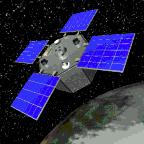
Active Cavity Radiometer Irradiance Monitor Satellite
Encyclopedia

NASA
The National Aeronautics and Space Administration is the agency of the United States government that is responsible for the nation's civilian space program and for aeronautics and aerospace research...
's Earth Observing System
Earth Observing System
The Earth Observing System is a program of NASA comprising a series of artificial satellite missions and scientific instruments in Earth orbit designed for long-term global observations of the land surface, biosphere, atmosphere, and oceans of the Earth. The satellite component of the program was...
program. ACRIMSAT was launched on 20 December 1999 from Vandenberg Air Force Base
Vandenberg Air Force Base
Vandenberg Air Force Base is a United States Air Force Base, located approximately northwest of Lompoc, California. It is under the jurisdiction of the 30th Space Wing, Air Force Space Command ....
as the secondary payload on a Taurus rocket
Taurus rocket
Taurus is a four stage, solid fuel launch vehicle built in the United States by Orbital Sciences Corporation. It is based on the air-launched Pegasus rocket from the same manufacturer. The Taurus rocket is able to carry a payload of around 1,350 kg into a low Earth orbit. First launched in 1994,...
along with KOMPSAT and placed into a high inclination, 700 km. sun-synchronous orbit
Sun-synchronous orbit
A Sun-synchronous orbit is a geocentric orbit which combines altitude and inclination in such a way that an object on that orbit ascends or descends over any given point of the Earth's surface at the same local mean solar time. The surface illumination angle will be nearly the same every time...
from which the ACRIM3 instrument monitors the total solar irradiance (TSI).
The ACRIM3 instrument has made state of the art measurements of the TSI
Sunlight
Sunlight, in the broad sense, is the total frequency spectrum of electromagnetic radiation given off by the Sun. On Earth, sunlight is filtered through the Earth's atmosphere, and solar radiation is obvious as daylight when the Sun is above the horizon.When the direct solar radiation is not blocked...
since the start of its Science Mission in April 2000. It extends the TSI measurement database begun by earlier ACRIM instruments on the NASA Solar Maximum Mission
Solar Maximum Mission
The Solar Maximum Mission satellite was designed to investigate solar phenomenon, particularly solar flares. It was launched on February 14, 1980....
(ACRIM1: 1980-1989) and Upper Atmosphere Research Satellite
Upper Atmosphere Research Satellite
The Upper Atmosphere Research Satellite was a NASA-operated orbital observatory whose mission was to study the Earth’s atmosphere, particularly the protective ozone layer. The satellite was deployed from Space Shuttle Discovery during the STS-48 mission on September 15, 1991...
(ACRIM2: 1991-2001).
Richard C. Willson is the principal investigator for the experiment and leads the ACRIM3 Science Team. Willson designed the active cavity radiometer type of sensor used by self-calibrating satellite TSI monitoring experiments today. The implementation of the ACRIM3 instrument was a collaboration between Willson, JPL/ACRIMSAT Project Manager Ronald Zenone and ACRIM3 Instrument Scientist Roger Helizon. The Mission is controlled using the ACRIMSAT tracking station at the JPL Table Mountain Observatory in Southern California. Co-Investigators are: Nicola Scafetta (climate impact of solar variability), Hugh Hudson (solar physics)and Alexander Mordvinov (solar physics).
ACRIMSAT (international designator
International Designator
The International Designator, also known as COSPAR designation, and in the United States as NSSDC ID, is an international naming convention for satellites...
1999-070B) is a spin-stabilized, single-purpose satellite constructed by Orbital Sciences Corporation
Orbital Sciences Corporation
Orbital Sciences Corporation is an American company which specializes in the manufacturing and launch of satellites. Its Launch Systems Group is heavily involved with missile defense launch systems...
. The end-to-end cost of the ACRIMSAT satellite, the ACRIM3 instrument, launch, ground station, operations and the science team activities during its 11 year mission to date has been less than $30 million - a good example of the efficacy of NASA's 'Better, Faster, Cheaper' initiative and ample evidence that inexpensive instrumentation and small dedicated satellites are the cost-effective approach for providing state-of-the-art TSI monitoring.
ACRIMSAT/ACRIM3 tracked the TSI during a 2004 transit of Venus
Transit of Venus
A transit of Venus across the Sun takes place when the planet Venus passes directly between the Sun and Earth, becoming visible against the solar disk. During a transit, Venus can be seen from Earth as a small black disk moving across the face of the Sun...
, and measured the 0.1% reduction in the solar intensity caused by the shadow of the planet.

